How Ashida Kim Met Stephen Hayes
Ninja Mission-INFILTRATION
The Back StoryShortly after Secrets of the Ninja, was published in 1981, I began to attract a new level of student. Many of them “cross-trained” in other styles and systems which, even in the eighties was still frowned upon by purists who held that a man should learn one art well rather than a hundred half-assed.
As a result I often received reports from these friends thereafter that my name often came up in a most disparaging way at seminars held by then solo Ninja master Stephen K. Hayes, as decreed by the various martial arts publications that took turns interviewing, publishing his books and sponsoring him. In spite of the fact that Sensei Ron Duncan from New York had trained in the dark art years before him. Or, that Sensei Robert Bussey and many others had trained with Japanese authority Masaaki Hatsumi but kept to the true Ninja tradition and hadn’t come back to brag about it.
Usually, these agents who had infiltrated the events, some on my behalf, some before meeting me, reported that their criticism of me consisted of calling me a fake and a fraud and, as published in their official Bujinkan Newsletter, feeling that it was “just a shame that so many people took me seriously.”
Had one student who later went into Marine Corps Intelligence, who had also trained with Ninja Master Steven Hayes. He told me several times that Hayes and his crew spent a lot of time bashing me and calling me a fake and he wasn’t sure why. I explained that it was just jealousy and unethical business practices, since everyone was aware of the “Never speak ill of a fellow Black Belt,” rule. At any rate, he thought this was a great insult and wanted to go and defend me to him. But, I usually fight my own battles, so I discouraged that.
A Ninja can never take such reports at face value. As Ronald Reagan said, “trust but verify.” And, this is a basic tenet of any intelligence gathering, to confirm by as many sources as possible the validity and accuracy of the information. Then too, there are always people who like to play a psychological game called “Let’s You and Him Fight” and try to provoke an argument for their own amusement at manipulating people. This is seen in the corporate world and global stage as well. Set your competitors against each other and let them destroy themselves so you can claim the market.
So, I decided to investigate on my own to see if it was true. I had had several other reports of this sort of propaganda being spread and figured if I met it head on and fought it out, that would pretty much settle it. So, I signed up for one of his seminars under an assumed name. To go there and be there and see if he bad-mouthed me. At which point I would, of course, appear, announce my presence and make a challenge.
Joe Beaver, one of Hayes’ students from his Atlanta dojo before he went to Japan and came back the anointed one, had moved to Florida and was hosting a seminar for his Sensei on the coast.
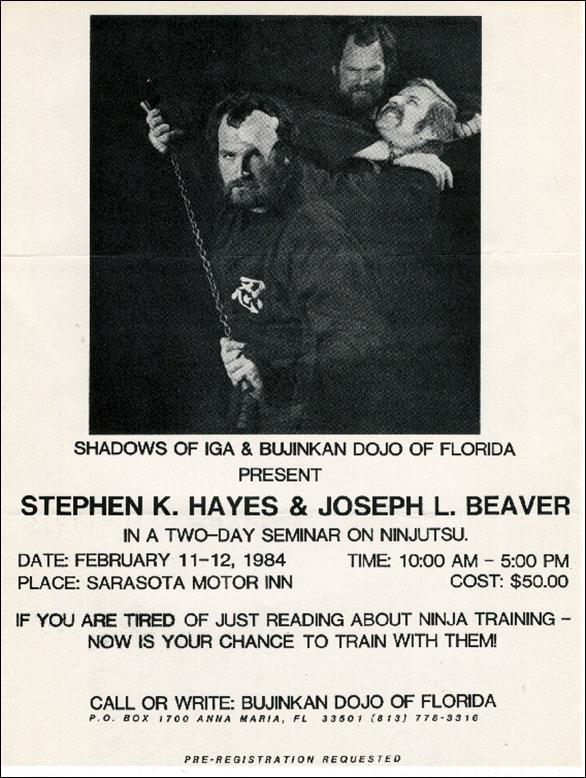
The Seminar
Saturday morning and I drove to the coast, found the Holiday Inn where the seminar would be held. I arrived early, an old Ninja trick, and scoped the place out. Did a quick survey of the layout and area. Parking at the far corner of the building, I waited for the event to commence. Saw a few people arrive and enter carrying workout bags or already dressed in black ghis.
Just before 9 a.m., about twenty minutes before the class was to begin, I saw a long black limo pulling into the parking lot. I figured that was Hayes. Sure enough, it pulled around to one of the side doors to the hotel. I got out of my car, pulled my bag out of the back and started down the sidewalk toward the entrance. The limo pulled alongside the curb as I reached the canopied doorway and the right rear door cracked open just as I passed the back tail light.
Just so happened that as I passed the back passenger side door of the limo, it popped open and out comes the great one himself, head down, looking at the curb. A bearded man in a black ghi with a pullover tunic turned in the back seat and extended his left leg toward the sidewalk. Bending forward, his head and shoulders came out of the car just as I stepped in front of him. He had no idea I was there at all. I could have clubbed him over the head and been gone before any of his buddies even made it out of the limo. But, I didn’t.
Instead, I waited till he looked up, did a quick bow and addressed him as Sensei. He looked up and smiled, still half trapped getting out with one hand on the door, one on the car frame, one leg in and one leg out of the vehicle, and replied Good Morning. I bowed again and stepped off quickly to get inside and change into my ghi. Would like to claim that my highly specialized Ninja senses enabled me to time it perfectly, or that the Force was with me, but eventually I wrote this off to just being lucky.
“How odd,” I thought. That karma had placed us in such a juxtaposition. Had I wanted to kill him, I had been given the perfect opportunity. No one had seen me approach the car. It wasn’t that I was hiding or lurking, just naturally quiet. Hayes had no idea I was in front of him until he looked up. I was completely invisible. It was a perfect one-man ambush on an official vehicle scenario. A single Poison Snake Piercing Venom (an underhanded fingertip strike to the root of the tongue) would have ruptured the Hypoglossal Artery. He would have fallen back into the car and choked on his own blood before anyone could save him; or know it was me. But, he wasn’t some medieval government official I was being paid to assassinate and this wasn’t feudal Japan. At worst, he was just a Karate teacher who was shooting off his mouth about someone he had never met. Besides, he had't insulted me yet. So, I let him live. Ha! Ha!
The seminar was very commercial. Beaver had rented a conference room in the hotel that could be opened up into a larger room if need be. There were about twenty-five people in attendance. The first thing I hated about the seminar was they “bumped the sale” on you when you got inside. The seminar was $50, but, when you got there, you had to buy a stick for $20 and a piece of rope (to simulate a chain) for $20 Otherwise, you couldn’t participate in any of the techniques they were teaching. Hanbos for stick fighting, knotted ropes to simulate chains for the Manriki techniques, real chains to take home, T-shirts, books, badges, pictures, books in Japanese by Hatsumi, books by Hayes and so on.
It was a pretty standard seminar. Hayes was an amiable instructor. He was introduced, did a short history and explained the boxing principle of taking a hit to give a hit, saying that he was willing to take a blow to the stomach, if it enabled him to strike the opponent in the head, which he figured would do more damage. Might be fine if you have Iron Body, but that wasn’t discussed. The First Rule of Self-Defense is: “Never take a hit you don’t have to.” The class was pleasant but busy. Seldom had enough time to practice a technique more than twice before he was moving on to the next. Okay for Black Belt level students, but most of these were not that advanced. The main thing was, no one got hurt.
We learned several “secret” Ninja techniques. One was a side-step, ridgehand to the throat under his arm, stomp on his knee to break him down and chop him to the back of the neck as he knelt move. It was curious why he left out the most obvious and self-protective knee to the stomach as you lift your leg to stomp his knee. I accidentally added it a couple of times. But then we moved on. Another self-defense technique was back-to-the-wall, knife to the throat, lift your instep into his groin as an escape. The, instep-to-groin strike is common in Judo, not a “secret technique” like he said at all. It is used to set up the corner throw or wheel throw by lifting the opponent off his feet as you fall back.
Problem is, when you do that, they almost always try to grab their groin. That would pretty much mean he would slice your throat as he tried to reach down. The real Ninja escape for this is to spit in his face. Then his hands go to his head, not through your neck, which temporarily blinds him AND he “falls back” away from you instead of leaning in as he would with a groin strike.
We practiced a variety of chain techniques. One against an overhead sword strike. Block by stretching the chain between two hand and catch the blade, step in and push forward, pulling the blade down behind his back, classic manriki-gusari technique with traditional weaponry, but good. Another was the principle of stepping in and striking the opponent with your shoulder as he raised his sword to strike you down. And, some arm-locking techniques with the stick we had bought. But, like the unarmed methods, there was only time to practice each move once or twice before we were moving on to the next. So, it was difficult for most people to grasp the techniques or remember them.
After lunch there was a good meditation session with a visualization about making a perfect cut with your mental sword. There were also a lot of new faces. People who hadn’t been there before lunch and who were practicing their own techniques together, things we had not been shown. I figured these were local students who “got a discount” or got in free as a promotion. Not a problem but a bit unfair to those who had paid and were only getting basic techniques because the place was a lot more crowded and there was less room to practice or see the podium. At the conclusion there was a group picture. I slipped out when the picture taking session started at the end of training. I had several opportunities to deliver a deathblow to Hayes during the class. Or, dispute what he was teaching. Once, when showing my training partner and myself a subtle part of a technique he bent forward in front of me, exposing his temple to a Buffalo Knuckle Strike. But, he had not mentioned my name a single time. In fact, he had not spoken of other schools at all. Merely done a good job to teach the syllabus and helping out his friend and former student. I faded quietly out the back. Didn’t want to let them know who I was. Hayes had passed the test. All day long he had been nothing but professional. He did not disparage me in any way. Leading me to conclude that either this was an isolated case, or that some of the “whistle-blowers” were actually making things up to encourage a challenge, or that they had somehow misinterpreted something he had said, or that such criticism was reserved for the inner circle. True enough there was an article in the Shadows of Iga Newsletter saying that the sad part of my existence was that so many people took me seriously. Usually when asked, Hayes and his crew would reply that they were “not impressed” with my skills. Of course, up till now, they had never seen any.
Later that week I wrote him a letter about the incident, appended, explaining who I was and why I had come, and he replied most politely. I didn’t go into all the details of how vulnerable he had been, just thanked him for not being an ass. He replied with a nice note thanking me for attending and hoping that we could train together again at some time in the future. From then on, he always appointed bodyguards to attend him and make sure no other nut like me could get close enough to challenge him. Because there are some out there that would do that, some have even tried with me.
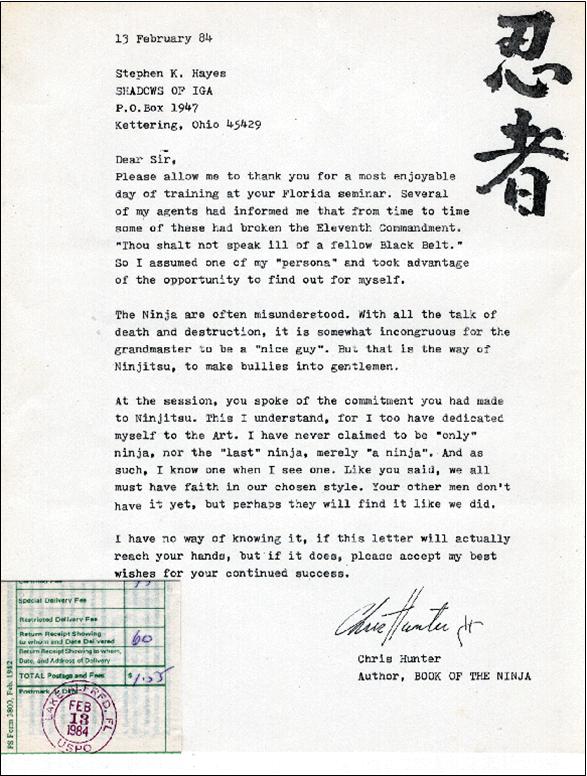
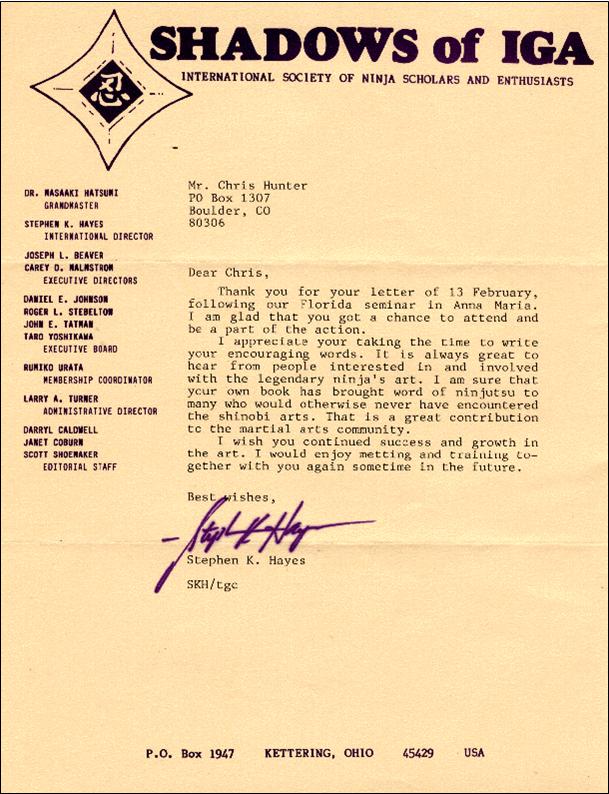
The Aftermath
After that a lot of the criticism of other Ninja quieted down and everybody sort of did their own thing. But, just like terrorists who succumb to a cult of personality, there are always self-motivated agents, or those given secret instructions to provide plausible deniability, who take it upon themselves to discourage any competition. Next time I did a seminar I had several students volunteer to bodyguard for me. I always told them that would be fine, but not to get in the way if trouble started.
In the 1980s America was introduced to a new martial art, Ninjitsu. In the early days, after WWII, there had been only Judo, the “gentle way” a sport form of Japanese wrestling taught in public schools for good health and physical education. Hidden in that was Atemi-waza, the striking techniques that could render an opponent senseless with a single blow. None of these were “secret” techniques. They were just not available to the general public. Keye Luke used a version of Dim Mak when he played Kato in the movie serial adventures of the Green Hornet in 1939. He strikes a gangster sentry and tells Brit Reed, “That blow will keep him out for half an hour…”
After that, in the fifties, Kara-te, the “empty hand” punching and kicking methods became known, and with that, the secret of vital and fatal point striking. Then Acupuncture was discovered by the West and the dark side of that art, the Poison Hand, began to be discussed. In the seventies, it was Kung Fu and the health and longevity exercises of Tai Chi that soared to popularity. Seemed like the spectrum of martial arts had pretty much been fulfilled.
Then came Stephen Hayes. Ordinary enough looking guy, friendly and affable, got a pretty good story about how he learned all these secret techniques and married into the Ninja clan in less than two years, saying that you could be Batman, complete with hood and mask and utility belt full of neat toys; all for sale at a reasonable price. Only get the authentic stuff though. He made a fortune with his clubs and seminars and franchises. “It’s all in da merchandising…” as Mel Brooks' Yodel from Space Balls would say. Hey! That’s the American dream, right? Free enterprise and all those other empty promises. Once Hayes “broke the code of silence” and began publishing and teaching Ninjitsu, Ashida Kim, Frank Dux and others like Robert Bussey and James Loriega came forward to let it be known that Hayes was not the only American Ninja. Each presented their interpretation of the Silent Way, but none were more successful than Hayes. He had “cornered the market” by making deals with all the magazines to promote himself and his designated companions as the only legitimate agents of this fantasy. So everyone else was discredited and ignored. He probably helped some people along the way, whether he meant to or not. What brought him down was arrogance. Not even his own, but rather that of his instructors who began to see everyone except their elite few as victims to be fleeced. Often secretly referring to seminar participants behind their backs as "coconot shrimp people." Meaning that they weren't there to learn anything and no one was going to teach them anything. Just take their money to pay for expensive dinners like "coconut shrimp" at the fancy restaurants. Eventually, internal political forces either saw through his game or otherwise thought he had dishonored the cult they had formed and “took down his shingle” (removed his teaching certification), from the flagship Bujinkan Dojo and rolls. Among their ryuha, a sign of disgrace.
His Ninja master, Masaaki Hatsumi had been recognized as an authority on the ninjtisu for many years. The very first publication that mentioned the then unknown art of Ninjutsu in the west, was an article featuring Dr. Hatsumi that appeared in Argosy magazine in 1961. Hatsumi was already quite well known In Japan at that time, but this was the first time that those in the west had ever been introduced to the Ninja.

In Martin Faulks book Becoming a Ninja Warrior, he relates how, after training with many masters and finding them all flawed, he actually went to Japan to train with Hatsumi and was told bluntly that they no longer teach Ninjitsu to gaijin (Westerners) and that what was taught to Hayes was not true Ninjitsu at all. Thus, Hatsumi and Hayes have discredited themselves and most all those other ryuha and “ninja masters” who sprang up during the “ninja craze” are gone, or have reverted back to their original traditional styles.
Only Ashida Kim remains. Proof of that is when “serious” students like Martin Faulks spend years training and practicing and paying for lessons to learn nothing and then come to him for an endorsement and review of their work.
Proof is when the so called "legitimate publishers" who stole his books to make their own fortunes re-releases one of his best selling early books, Secrets of the Ninja 1981, in 2009 to promote the bogus works of their “in-house author” Ha Ha Lung because a lot of people think that is one of Ashida Kim's “secret identities.” Just another example of how much influence his writings and teachings hve had, when people impersonate him to or pretend to be his friend to sell their wares.
Proof is when secondary rights to Secrets of the Ninja and Secrets of the Invisibility are still being sold in 2014 to even more fly-by-night publishers; so even more bogus editions can be printed and still other cronies can line their pockets with gold at Master Kim's expense. Making his books the best selling works on the subject of Ninjitsu for more than thirty years. Ninja Mind Control is the single best selling book ever on Ninja meditation worldwide.
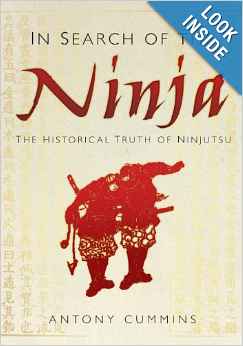
Antony Cummins recently published book, In Search of the Ninja, confirms virtually everything Kim-Sensei has ever said about Ninjitsu. Kim has always said that Ninjitsu came to Japan from China. Antony Cummins and his Historical Ninjutsu Research Team have proven it beyond the shadow of a doubt. In meticulous detail they demonstrate the evolution, definition and usage from ancient scrolls of the ideograms for stealth and spying. Using the recognized classic Ninja texts, they compare the instructions of such masters as Sun Tzu to the guidelines provided for the feudal age Ninja by their Tora-Maki or sacred scrolls. They are obviously the same.
Other historical researchers are discovering that Ninjitsu is indeed a “magickal” art, basing many of its techniques and philosophy on arcane principles and occult practices. Some new translations of the Bashushenkai, considered to be the definitive text on feudal Ninjitsu confirm that the type of techniques given in Secrets of the Ninja, such as sentry removal and infiltration, covert entry and so on actually make up the bulk of the material, NOT simple basic martial arts axioms of balance and leverage. So, once again, Ashida Kim is vindicated in maintaining that what he is teaching is the true Shinobi-jitsu designed for soldiers and warriors and not some watered down commercialized scam to sell you a black hood so you can pretend you are Batman. For these reasons and many more, in the year of the Black Dragon, Kim-Sensei was awarded the title Father of 21st Century Martial Arts and Grand Patriarch of Modern Day Ninjitsu by his students, peers and grandmasters at a ceremony in Ft. Walton Beach FL.
Comparatively speaking, while Ninja are known as weapons masters, Ashida Kim is the only one to have shown how to fight and vanish with a blanket or cape in his work entitled, Cloak of Invisibility. Ninja are known as wizards and magicians, but only Kim has shown how to perform magic tricks in his book Ninja Levitation. Ninja are said to hold the secrets of enlightenment and the mysteries of the universe, but only Ashida Kim addresses these issues, in Ninja Death and Reincarnation.
Ashida Kim does not claim to be a sixteenth century cloak and dagger assassin as others would have you believe. He does lay claim to being a prolific author, a philosopher, a teacher and a student of the martial arts, and of life. Perhaps, Ashida Kim’s greatest contribution to martial arts is his steadfastness against all the odds. In fact, the kanji for “Ninjitsu” in Japanese translates as “endurance in the face of adversity,” in Chinese.
The evil perpetrated against Kim and so many others is evidence enough and the reason we need to demand “professionalism,” with viable safeguards in which internet sites and publishers are held accountable for their actions or in this case, their inaction, and sins of omission. We need to turn our backs on and not reward those who make use of unscrupulous and unfair business practices to get ahead.
And it would be easy to turn the tables and vilify Masaaki Hatsumi or Stephen K. Hayes, that would be oversimplifying a complex situation and doing a disservice to the martial arts community and to them. Perhaps, they were left with no choice but to go along with the marketing plan that enriched the publishers or risk facing the consequences Kim and others must endure as a result of their being labeled and falsely accused with no opportunity to respond effectively or make a defense.
To quote Ashida Kim, “Most of what is portrayed as Ninjutsu in movies and popular books is far from the actual art, as it was taught to me. The first Teenage Mutant Ninja Turtles movie was a very good presentation of the real philosophy of non-violence that is the true foundation of the system. It had lots of invisibility techniques, lots of philosophy. Most of the rest of Ninja movies are just standard revenge plots with buckets of blood and what the producers think are exotic techniques but are only good for entertainment purposes.”
Martial arts are not about fighting. They are about becoming a better person so that you can set a good example for all. They are about empowering the individual to stand up for himself so he can do the right thing. With great power comes great responsibility. The power to kill and restore to life is not given to just anyone, for then it might be misused. But, everyone has it within them to have this power. There is no one art that is greater than another. All are a matter of personal skill. On any given day, even the greatest champion can be beaten. By competing against each other we discover ourselves. By training with the best we continue to grow and learn.
The taking of a life does no one honor. The use of deadly force is only justified in self-defense. For all life is precious, nor can any be replaced. But, every time you pick up a handful of sand and see not just the sand, but a marvel, a miracle there in your hand. Every time you take a breath and think to yourself, “I’m alive and being alive is fantastic.” Every time you do that you are part of the circle of life. And the game of life is finding worthy companions with which to make the journey anew each day.
Let us therefore come together, to set a good example for all, to be the heroes of our own lives, the captains of our fate, the masters of our souls. To live our lives as an exclamation rather than an explanation. Let us not “enjoy the suffering that is our lives” but rather alleviate that pain and put things right. There is a great evil loose in the world today. When we meet it we must do our worst so that the greater good will prevail. Not everyone is strong enough to fight back. But, we have forged our bodies in the fire of our will. We are men of peace who fight like ten tigers. And, for this help we once received, it became our obligation to help ten others. In this way good deeds will spread out like the ripples on a pond and cover the whole earth.
UPDATE 2018
I presented this narrative not to brag, or boast, or imply any threat. But, rather as an example of how Ninja still living in the modern world, deal with a Mind Game used by bullies called, “Let’s You and Him Fight!” Very similar to Agent Provocateur techniques in Ninja Espionage. And how, because of my training, I was aware of this sinister manipulation attempt for reasons unknown by people that should have been trustworthy. Perhaps they heard a rumor and believed it. Perhaps they had read Hayes’ quote in their Official Bujinkan Newsletter that he was “not impressed” with what he had seen of my skills. There are many reasons why a Ninja or a bully might play this game, even commercial.
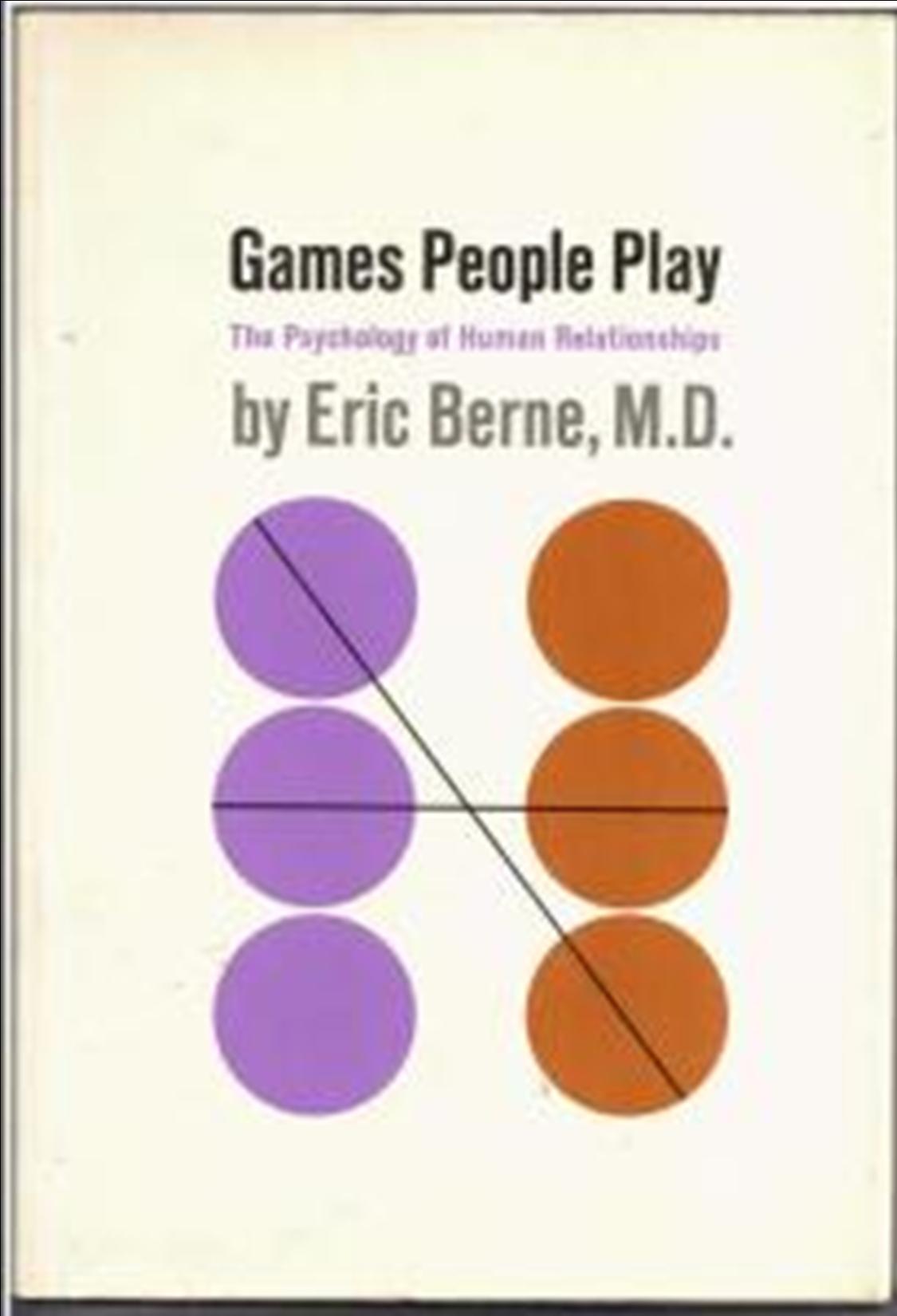
As described by Dr. Eric Berne in Games People Play, 1964, “This may be a maneuver, a ritual or a game. In each case the psychology is essentially feminine. Because of its dramatic qualities, LYAHF is the basis of much of the world’s literature, both good and bad.
1. As a maneuver it is romantic. The woman maneuver or challenges two men into fighting, with the implication or promise that she will surrender herself to the winner. After the competition is decided, she fulfils her bargain. This is an honest transaction, and the presumption is that her and her mate live happily ever after.
2. As a ritual, it tends to be tragic. Custom demands that the two men fight for her, even if she does not want them to, and even if she has already made her choice. If the wrong man wins, she must nevertheless take him. In this case it is society and not the woman who sets up LYAHF. If she is willing, the transaction is an honest one. If she is unwilling or disappointed, the outcome may offer her considerable scope for playing games, such as ‘Let’s Pull A Fast one on Joey.'
3. As a game it is comic. The woman sets up the competition, and while the two men are fighting, she decamps with a third. The internal and external psychological advantages for her and her mate are derived from the position that honest competition is for suckers, and the comic story they have lived through forms the basis for the internal and external social advantages.”
To the agent provocateur it is simply a matter of telling each side that they other has somehow insulted him. Or, stolen from him, or made a pass at this wife. Any of the commonly used motivations to incite one party against another. So long as the information is believed, which requires the trust of the victims, the agent can “play both sides against the middle” and manipulate his victims to their own detriment for his personal entertainment and enrichment. This sort of thing happens all the time in office politics and on the job. Usually born of jealousy, greed or selfish ambition.
In this instance, I was told a story and using the intelligence gathering principle of confirming that story, I discovered it to be false. So, there was no harm done and no insult intended. I bring this up to rectify another misunderstanding.
Recently, I was honored to receive an award from Alan Goldberg’s Action Martial Arts Hall of Fame in recognition of my longevity and martial arts time-in-grade. At this extravaganza there were many dignitaries and icons of American fistic and grappling arts. Such as Bob Backlund, Mark Henry, David Furie, Don “The Dragon” Wilson, Benny Urquidez, Cynthia Rothrock, Samuel Kwok, Greg Duncan, Livingston Kelly, Bob Goldman, Mark Shuey, Tim Wright, Rico Guy, Orlando Rivera, Kevin Cullen, Michael Depasquale Jr., Andrew Stigliano, Ron Lee, Don Miskel and many others.
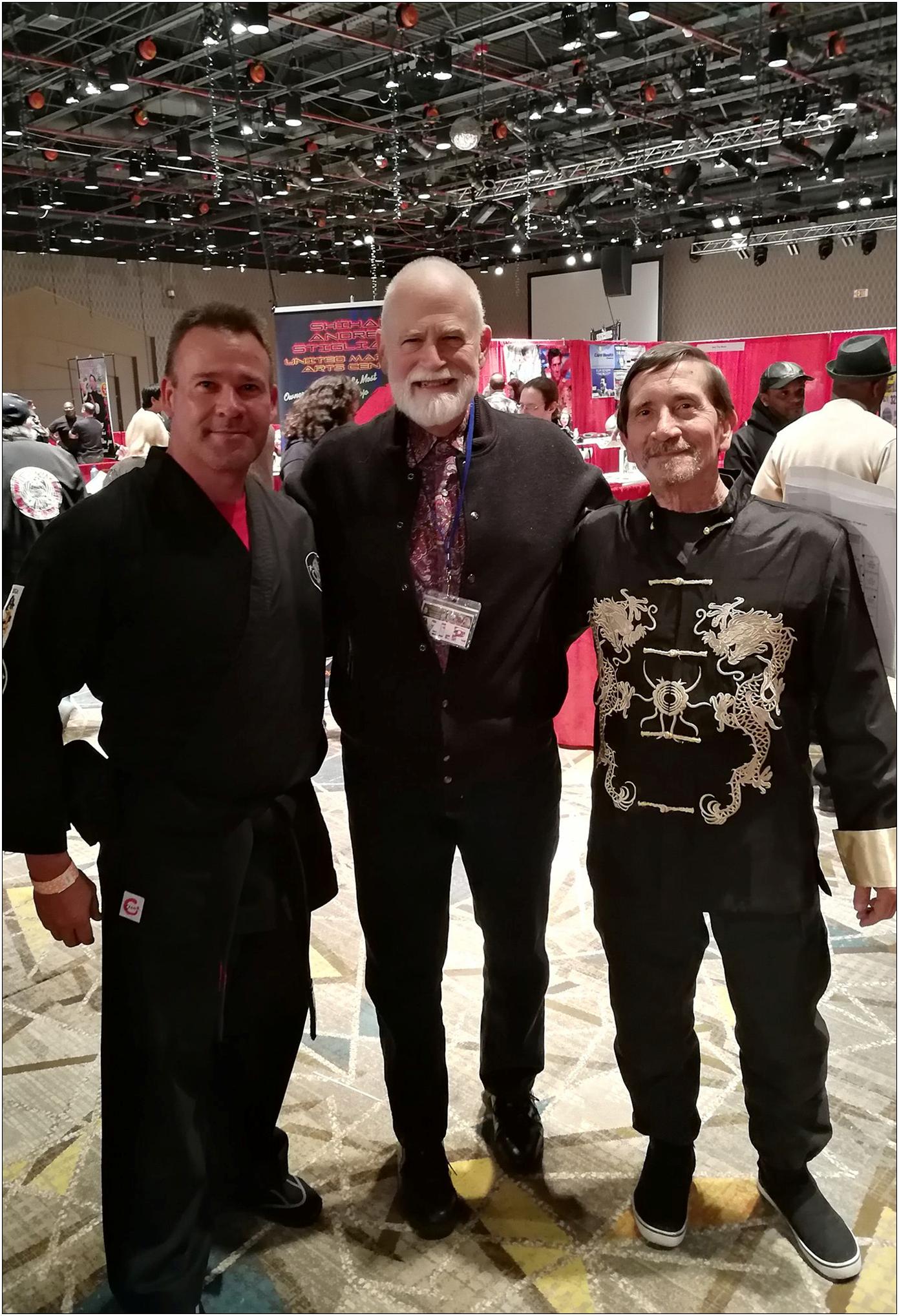
And, among them was Stephen Hayes. We had a booth near the entrance to the hall and were able to catch sight of him as he came in Friday morning. He was busy smiling, shaking hands and being welcomed. I waited my turn and stepped up as the last to greet him.
“Hello, sir,” I said. “Very nice to see you again.” We shook hands.
“And you are?” He asked.
“Ashida Kim,” I replied.
“Oh!” He said. “I thought you were dead.”
A picture of John Wayne playing Big Jake flashed in my head. “Not hardly,” I said, quoting the Duke.
We smiled and parted ways, each to our own vendor table.
Didn’t see much of him until his seminar presentation. He remains an excellent instructor, making the techniques clear and simple, smiling, gently correcting, gentlemanly and personable.
Had breakfast with him, Hendrik Strauss, David Furie, and Cary Tagawa on Sunday morning. We talked about Dalai Lama’s teachings on perception of reality, and family history. It was a wonderful meal and a good parting.
But, before that, shortly after Stephen Hayes had arrived, Shihan Strauss posted a picture of him and myself on his Facebook page. Immediately there were dozens of amazed responses.
“I thought those guys hated each other?!” Was the most common theme.
Let it be perfectly clear. I do not hate Shidoshi Hayes. Long ago, we were rivals in the marketplace with our books and teachings. Now we are not teaching the same thing. There are many different aspects to martial arts. My focus is on simple self-defense and Tai Chi. In keeping with the Shaolin tradition, I have been fortunate and learned more ways to heal rather than destroy.
So, take this as a lesson.
Don’t believe everything you hear. There is lots of fake news out there that may be trying to trick you. This is an example of it. There are many devils on the road.

